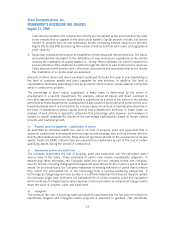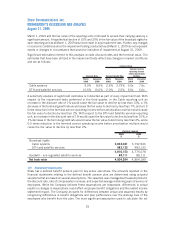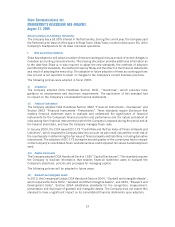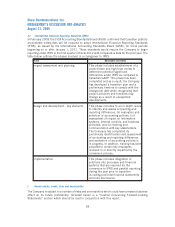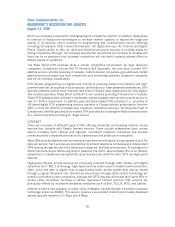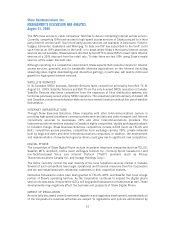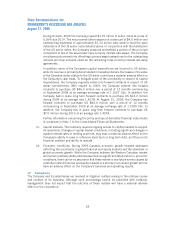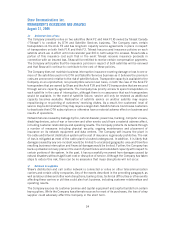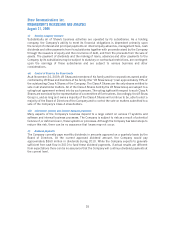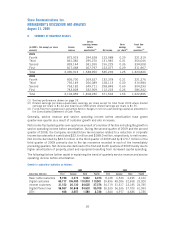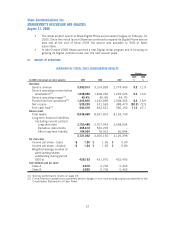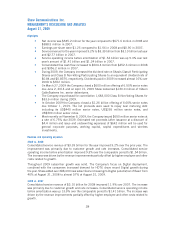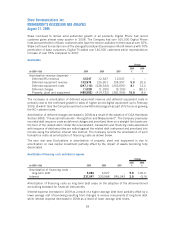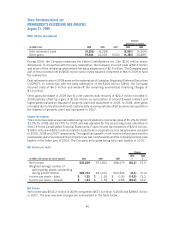Shaw 2009 Annual Report Download - page 34
Download and view the complete annual report
Please find page 34 of the 2009 Shaw annual report below. You can navigate through the pages in the report by either clicking on the pages listed below, or by using the keyword search tool below to find specific information within the annual report.which is a necessary component in strengthening its competitive position. In addition, Shaw plans
to continue to deploy new technologies to increase channel capacity, to expand the range and
quality of its services, and to enhance its programming and communication service offerings
including, for example, VOD, interactive television, full digital line-ups, HD, Internet and Digital
Phone. Shaw’s ability to offer its cable and telecommunications services in bundles allows for
strong competitive offerings. The Company expects that competition will continue to increase and
there can be no assurance that increased competition will not have a material adverse effect on
Shaw’s results of operations.
The Shaw Direct DTH business faces a similar competitive environment as cable television
companies. Competitors include Bell TV (formerly Bell ExpressVu, the only other licensed DTH
satellite service currently operating in Canada), cable television companies, grey and black market
satellite service providers and other competitors such as wireless operators, telephone companies
and off-air television broadcasters.
DTH delivers programming via signals sent directly to receiving dishes from medium and high-
powered satellites, as opposed to via broadcast, cable delivery or lower powered transmissions. DTH
services presently provide more channels than some of Shaw’s cable systems and are fully digital.
Two licensed operators, Shaw Direct and Bell TV, are currently providing DTH services in Canada.
These DTH operators have achieved considerable customer growth and currently provide service to
over 2.7 million subscribers. In addition, grey and black market DTH providers (i.e., providers of
US-based digital DTH programming services available in Canada without authorization from the
CRTC or from the US DTH providers) also constitute competitive services. The Supreme Court of
Canada has ruled that grey and black market DTH providers are violating the Radiocommunication
Act, and are therefore providing an illegal service.
INTERNET
There are a number of different types of ISPs offering residential and business Internet access
services that compete with Shaw’s Internet services. These include independent basic access
service providers (both national and regional), incumbent telephone companies and wireless
communications companies and electricity transmission and distribution companies.
Many ISPs provide telephone dial-up Internet access services with typical access speeds of up to 56
kbps per second. Such services are provided by incumbent telephone companies and independent
ISPs (mainly through the use of the telephone companies’ facilities and services). According to the
2009 Communications Monitoring Report issued by the CRTC, approximately 8% of all Internet
subscribers in Canada use low-speed dial-up access services, while the other 92% use high-speed
services.
High-speed Internet access services are principally provided through cable modem and digital
subscriber line (“DSL”) technology. High-speed services enable users to transmit and receive text,
video, voice and data in digital form at significantly faster access speeds than dial-up access
through a regular telephone line. Internet access services through cable modem technology are
primarily provided by cable companies, although the CRTC has also authorized third-party ISPs to
access cable companies’ facilities to deliver high-speed Internet services. DSL services are
principally offered by incumbent telephone companies such as Bell, TELUS, MTS, and Sasktel.
Internet access is also available in select cities in Western Canada through a wireless microwave
technology known as WiMAX. This service requires a specialized modem and provides download
speeds typically between 512 Kbps and 3 Mbps.
30
Shaw Communications Inc.
MANAGEMENT’S DISCUSSION AND ANALYSIS
August 31, 2009





